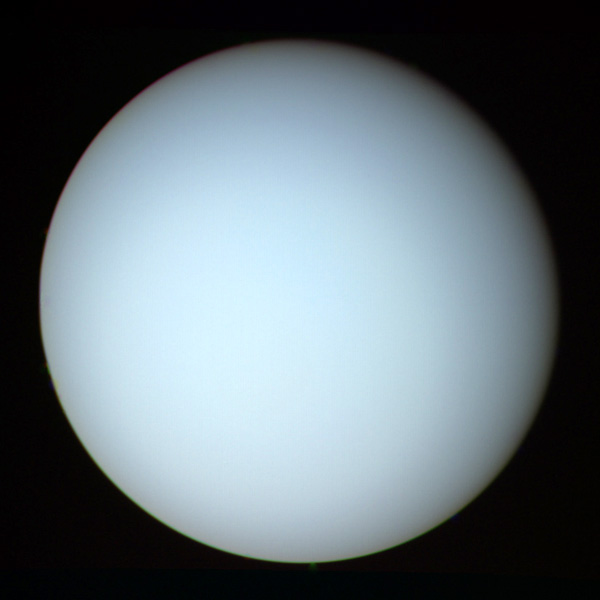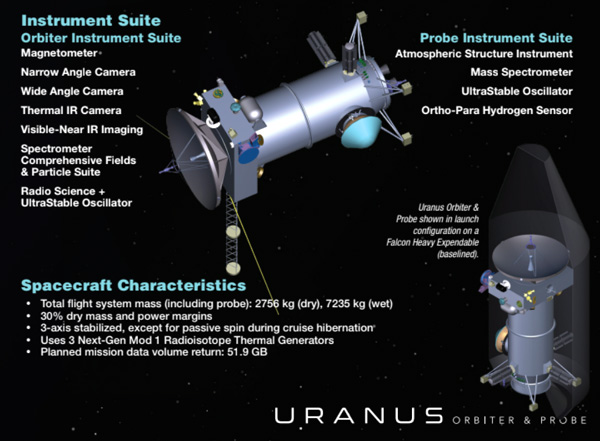
NASA / JPL
Report Identifies Priority Planetary Science Missions, Planetary Defense Efforts, and Strategic Investments for the Next Decade (News Release)
WASHINGTON — A new decadal survey from the National Academies of Sciences, Engineering, and Medicine identifies scientific priorities and opportunities and makes funding recommendations to maximize the advancement of planetary science, astrobiology, and planetary defense in the next 10 years.
The recommendations by the steering committee for the decadal survey draw on input from the scientific community through the advice of six panels, hundreds of white papers, invited speakers, outreach to advisory groups and professional society conferences, and work with mission-design teams.
“This report sets out an ambitious but practicable vision for advancing the frontiers of planetary science, astrobiology, and planetary defense in the next decade,” said Robin Canup, assistant vice president of the Planetary Sciences Directorate at the Southwest Research Institute, and co-chair of the National Academies’ steering committee for the decadal survey. “This recommended portfolio of missions, high-priority research activities, and technology development will produce transformative advances in human knowledge and understanding about the origin and evolution of the solar system, and of life and the habitability of other bodies beyond Earth.”
The report identifies three high-level scientific themes — origins, worlds and processes, and life and habitability — and defines 12 priority science questions to help guide mission selection and research efforts in planetary science and astrobiology.
Origins, Worlds, and Life: A Decadal Strategy for Planetary Science and Astrobiology 2023-2032 recommends NASA missions that are balanced across three cost classes, and considers both ongoing and potential future missions in order to enable a steady stream of new discoveries and support the capability to make major scientific advances. The small-class Discovery program supports principal investigator (PI)-led missions that address focused science objectives with a high launch cadence. Medium-class missions like those in the New Frontiers program are PI-led and address broader science goals. Large-class flagship missions address broad, high-priority science objectives with sophisticated instrument payloads and mission designs.
Priority Flagship Missions
The Uranus Orbiter and Probe (UOP) should be the highest-priority large mission, the report says. The UOP would conduct a multi-year orbital tour to transform knowledge of ice giants in general, and the Uranian system in particular, through flybys and the delivery of an atmospheric probe. The report states that UOP would be programmatically complementary to the flagship missions underway, and that a launch within the 2023-2032 decade is viable on currently available launch vehicles.
The Enceladus Orbilander should be NASA’s second-highest priority large mission, the report says. The Orbilander would search for evidence of life on Enceladus, a moon of Saturn, from orbit and during a two-year landed mission that would perform detailed studies of fresh plume material originating from Enceladus’ interior ocean.
State of the Profession
The state of the profession — including its diversity, equity, inclusivity, and accessibility (DEIA) — is central to the success of the planetary science enterprise. The report encourages the engagement of students from underrepresented communities at secondary and college levels to support and retain them along planetary science and astrobiology pathways, and to create and sustain a diverse planetary science community.
“While scientific understanding is the primary motivation for what our community does, we must also work to boldly address issues concerning our community’s most important resource — the people who propel its planetary science and exploration missions,” said Philip Christensen, Regents Professor in the School of Earth and Space Exploration at Arizona State University, and steering committee co-chair. “Ensuring broad access and participation in the field is essential to maximizing scientific excellence and safeguarding the nation’s continued leadership in space exploration.”
A healthy scientific community needs an environment free of hostility and harassment, the report says. It recommends that NASA’s Planetary Science Division (PSD) implement codes of conduct for its missions, conferences, and field campaigns, and that NASA, NSF, affiliated institutions, and professional societies work to mitigate bias at all levels. This effort should include analysis of decision-making practices and procedures, and engagement with the community to develop creative initiatives to uncover and mitigate bias.
There is a pressing need for data-gathering efforts on the size, identity, and demographics of the planetary science and astrobiology community, as well as a surveying of workplace climate, the report states, as any efforts toward equity and accountability in the community rely on having complete data.
Planetary Defense
Planetary defense is part of an international cooperative effort to detect and track objects that could pose a threat to life on Earth and an element of NASA’s planetary science endeavors concerned with human health and safety. The report’s recommendations focus on enhancing near-Earth object (NEO) detection, tracking, and characterization capabilities; improving NEO modeling, prediction, and information integration; and developing technologies for NEO deflection and disruption missions.
NASA should fully support the development, timely launch, and subsequent operation of the NEO Surveyor, a dedicated, space-based mid-infrared survey, to achieve the highest-priority planetary defense NEO survey goals, the report says. Following the NEO Surveyor and Double Asteroid Redirection Test, the highest-priority planetary defense demonstration mission should be a rapid-response, flyby reconnaissance mission targeted to a challenging NEO of 50 to 100 meters in diameter — which is representative of the population of objects posing the highest probability of a destructive Earth impact. Such a mission should assess the capabilities and limitations of flyby characterization methods to better prepare for a short-warning time NEO threat.
New Frontiers and Discovery Programs
As mission themes for the New Frontiers program, the report recommends that NASA include a Centaur Orbiter and Lander, Ceres sample return, comet surface sample return, Enceladus multiple flyby, Lunar Geophysical Network, Saturn probe, Titan orbiter, and Venus In Situ Explorer. These mission themes were chosen based on how well each would address the priority-science questions identified, and a consideration of programmatic balance, destination class, cost, technical readiness, and scientific merit.
Though the report does not make specific recommendations for small missions, the committee found that the Discovery program has made important scientific contributions and that future missions can address a rich array of science. Therefore, NASA should continue to support Discovery at a high cadence of two missions per announcement of opportunity, in which NASA publicly solicits proposals.
Exploration Programs
Mars and the Moon each provide the opportunity to investigate a wide range of priority-science questions at relatively easy-to-reach destinations, and these justify the Mars Exploration Program (MEP) and the Lunar Discovery Exploration Program (LDEP) as dedicated programs, according to the report. It recommends NASA develop scientific exploration strategies in other areas of broad scientific importance, such as Venus and ocean worlds, that have an increasing number of U.S. missions and international collaboration opportunities.
NASA should maintain the MEP and prioritize the Mars Life Explorer (MLE) as the next medium-class MEP mission. While the Mars Sample Return (MSR) looks for ancient biosignatures, the MLE would seek extant life and assess modern habitability. The prior decadal survey recommended a Mars sample-caching rover as NASA’s top priority flagship mission, which is being implemented as the MSR program. The new decadal survey reaffirms the broad and fundamental scientific importance of MSR, and says the highest scientific priority of NASA’s robotic exploration efforts this decade should be MSR’s completion as soon as practicably possible with no change in scope. However, it cautions that the cost of MSR should not be allowed to undermine the long-term programmatic balance of the planetary portfolio. If costs increase substantially, NASA should take strong efforts to secure a budget augmentation to ensure the success of this strategic mission.
PSD should execute a strategic program to accomplish lunar planetary science and implement a structured, science-led approach to provide scientific requirements for the Artemis program. This effort should have an organizational structure that aligns responsibility, authority, and accountability.The report prioritizes implementation of Endurance-A as the highest-priority medium-class mission for the LDEP. Endurance-A would utilize commercial lunar payload services to deliver a rover that would collect a substantial mass of high-value samples across a long traverse, delivering them to astronauts for return to Earth. This coordinated approach provides a large opportunity to expand the partnership between NASA’s human exploration and scientific efforts at the Moon. The report notes that this coordination will require an organizational structure that empowers PSD and LDEP to provide scientific requirements to the Artemis program.
Funding, Infrastructure, and Technology
The report contains a suite of recommendations aimed at ensuring there is the funding, infrastructure, and technology needed to support the prioritized missions and other research efforts going forward. For example, PSD should progressively ramp up its investment in research and analysis (R&A) activities to a minimum annual-funding level of 10% of its budget. Strong, steady investment in R&A is needed to ensure a maximal return of mission data, that data drives understanding and novel testable hypotheses, and that advances feed into future mission development.
NASA’s level of planetary technology funding has declined over recent years to just 4% and now falls short of recommended levels of investment. The report says PSD should fund technology advancement at an average of 6% to 8% of its budget in order to achieve the significant technology advancements that will be needed to accomplish strategic research and missions prioritized in the report.
NSF-supported, ground-based telescopic observations provide critical data that help in addressing important planetary science questions, and NSF should continue, and if possible expand, funding to support existing and future observatories and related programs.
The study — undertaken by the Planetary Science and Astrobiology Decadal Survey 2023-2032 Steering Committee — was sponsored by NASA and NSF. The National Academies of Sciences, Engineering, and Medicine are private, nonprofit institutions that provide independent, objective analysis and advice to the nation to solve complex problems and inform public policy decisions related to science, technology, and medicine. They operate under an 1863 congressional charter to the National Academy of Sciences, signed by President Lincoln.
Source: NationalAcademies.org
****


No comments:
Post a Comment